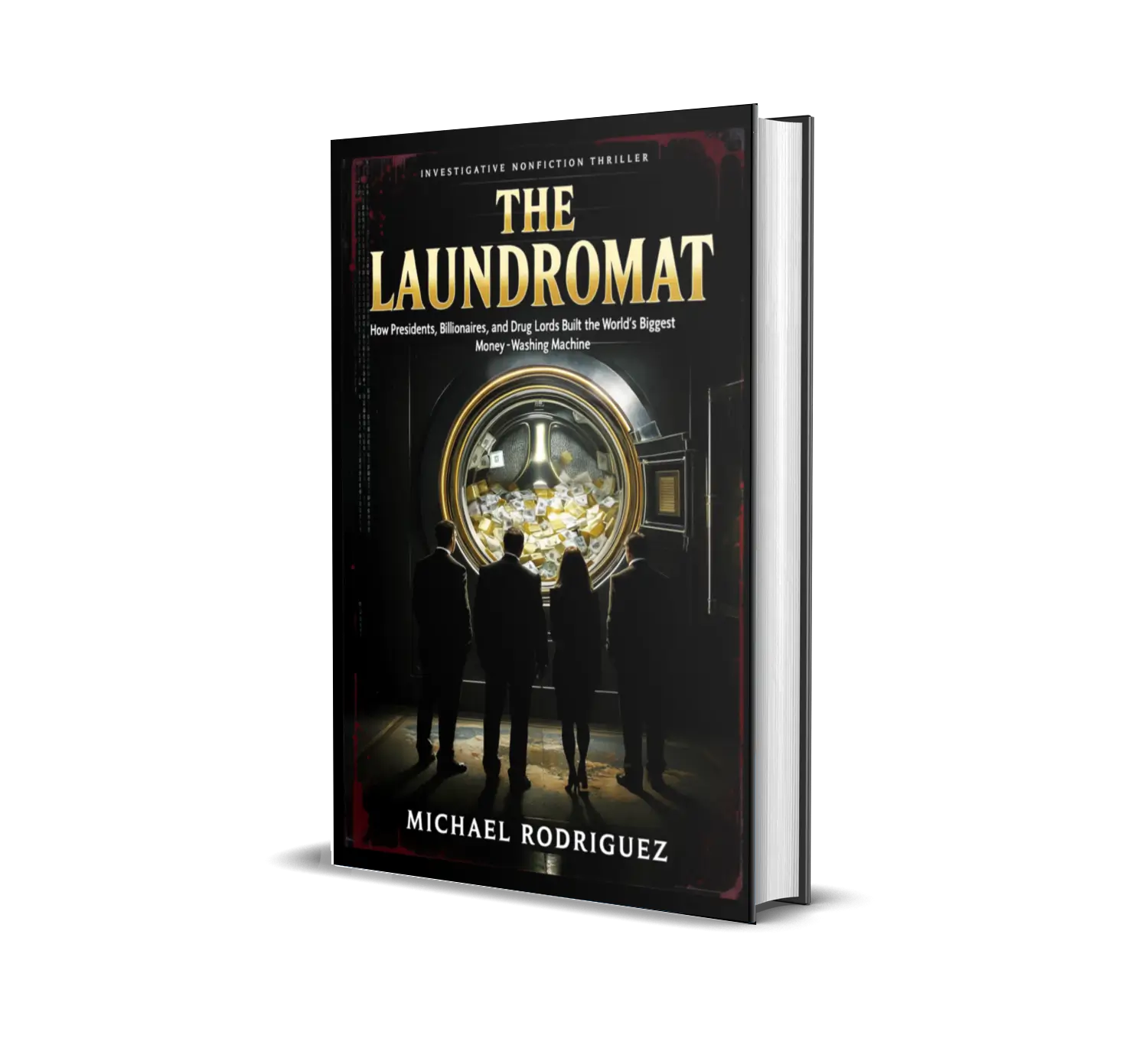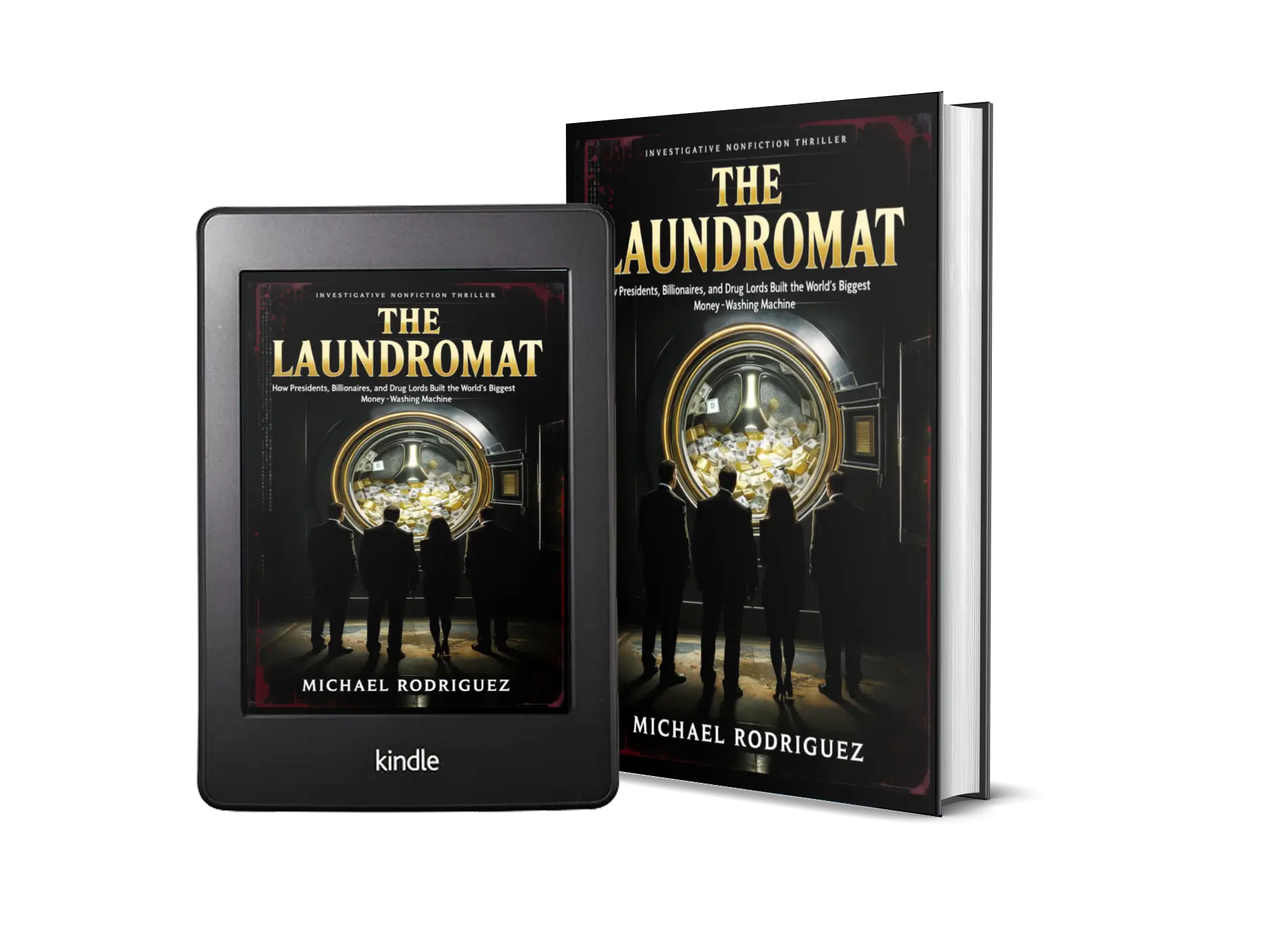Money Laundering FAQ: 12 Essential Questions Answered
Published on July 24, 2025

At exactly 3:47 AM on March 15, 2019, Sarah Chen's phone buzzed with an alert that would expose one of the largest financial crimes in history. The forensic accountant had been tracking suspicious wire transfers for months, but this transaction was different. In less than four minutes, $847 million had moved through seven countries using a sophisticated network that appeared completely legitimate on the surface. Sarah had just discovered a single thread in what investigators now call "the world's biggest money-washing machine" – a $32 trillion shadow economy larger than the combined GDP of America and China. Her discovery launched the investigation that would eventually uncover how presidents, billionaires, and drug lords built the most sophisticated criminal financial system in human history, as comprehensively documented in The Laundromat: How Presidents, Billionaires and Drug Lords Built the World's Biggest Money-Washing Machine.
Q1: What Exactly Is Money Laundering?
The Simple Answer: Money laundering is the process of making criminally-derived money appear legitimate by disguising its true source.
The Complete Reality: Think of it as a financial washing machine that takes "dirty" money from illegal activities and puts it through a cycle of transactions that "cleans" it, making it look like proceeds from legal business. But here's what most people don't understand: modern money laundering isn't just about hiding drug money or mafia profits. Today's operations process everything from tax evasion to sanctions violations, from terrorist financing to political corruption.
When a billionaire uses 47 shell companies to hide assets from taxation, when a dictator moves stolen state resources to Swiss accounts, when a corporation creates fake invoices to avoid paying fair taxes – all of this is money laundering. The scale is staggering: conservative estimates suggest that $2-4 trillion is laundered globally each year, but the real figure could be much higher when you include sophisticated schemes that exploit legal loopholes and regulatory gaps.
Q2: How Does the Money Laundering Process Actually Work?
The Traditional Model: Classic money laundering follows three stages, but modern operations have evolved far beyond this simple framework.
Placement: Criminals introduce illegal money into the financial system. In the 1980s, this meant physically depositing cash at banks. Today, it might involve purchasing cryptocurrency, buying luxury goods, or investing in real estate.
Layering: The money is moved through complex transactions to obscure its origin. Modern layering can involve hundreds of shell companies across dozens of countries, automated trading algorithms, and even NFT purchases that create seemingly legitimate transaction histories.
Integration: The "cleaned" money is reintroduced into the economy as apparently legitimate funds. This might appear as business profits, investment returns, or proceeds from asset sales.
The Shocking Reality: Today's most sophisticated operations skip traditional banking entirely. They use AI-powered systems that automatically route money through cryptocurrency exchanges, privacy coins, and decentralized finance platforms while generating false documentation and creating fake business justifications in real-time.
Q3: Why Is Money Laundering So Dangerous to Society?
Beyond Individual Crime: Money laundering isn't a victimless crime – it's a systematic theft from democratic societies. Every dollar hidden offshore represents unpaid taxes that should fund schools, hospitals, and infrastructure.
The real danger lies in how money laundering enables other crimes. Drug cartels couldn't exist without sophisticated financial networks to process their profits. Terrorist organizations need money laundering to fund operations. Corrupt politicians require offshore accounts to hide bribes and stolen public resources.
Perhaps most insidiously, money laundering undermines democratic governance itself. When unlimited anonymous funds can influence elections and policy decisions, the concept of "one person, one vote" becomes meaningless. Oligarchs and criminal organizations end up with more political influence than entire populations.
Q4: How Much Money Is Actually Laundered Each Year?
The Honest Answer: Nobody knows the true scale because successful money laundering is, by definition, undetected. But the estimates are breathtaking:
- The United Nations estimates that $800 billion to $2 trillion is laundered annually through traditional financial systems
- When you include tax evasion, offshore wealth hiding, and corporate profit shifting, the shadow economy reaches $32 trillion
- Cryptocurrency money laundering exceeded $14 billion in 2021 and continues growing exponentially
- Real estate money laundering in major cities involves billions in anonymous purchases annually
To put this in perspective: the shadow economy is larger than the legitimate economies of every country except the United States and China. It's money that exists, moves, and generates profits while remaining completely invisible to democratic oversight.
Q5: What Are the Most Common Money Laundering Methods Today?
Modern Techniques: Today's money laundering has evolved far beyond crude cash-based schemes:
Cryptocurrency Mixing: Criminals use "tumbling" services that combine their digital currencies with thousands of other transactions, making it nearly impossible to trace the original source.
Real Estate Washing: Luxury properties serve as perfect money laundering vehicles. A Russian oligarch can buy a $50 million Manhattan penthouse with criminal proceeds, hold it for two years, then sell it as "clean" investment returns.
Shell Company Networks: Criminals create layers of anonymous companies in different jurisdictions, each owning pieces of legitimate businesses or assets. These structures can be so complex that investigators spend years just mapping the ownership chains.
Trade-Based Laundering: This involves manipulating trade documents to move money across borders. Criminals might invoice a shipment of electronics at 500% above market value, with the excess payment representing laundered funds.
AI-Powered Automation: The newest frontier involves artificial intelligence systems that conduct thousands of micro-transactions automatically, learning and adapting to avoid detection patterns faster than human investigators can identify them.
Q6: How Do Banks Detect Money Laundering?
The Theory: Banks are required to monitor transactions for suspicious patterns and report potential money laundering to authorities. Modern banks use automated systems that flag transactions based on predetermined criteria: large cash deposits, unusual wire transfer patterns, transactions involving high-risk countries.
The Reality: It's a cat-and-mouse game where criminals consistently stay ahead of detection systems. Banks process billions of transactions daily, generating millions of "suspicious activity reports" that overwhelm investigative capacity. Meanwhile, sophisticated criminals design their operations specifically to avoid triggering these automated alerts.
The Dirty Secret: Some major banks have been caught actively facilitating money laundering for years while paying fines that represent just a tiny fraction of their criminal profits. When JPMorgan Chase pays a $2.9 billion fine for processing Jeffrey Epstein's suspicious transactions, these penalties function more like business licenses than meaningful deterrents.
Q7: What Are the Legal Penalties for Money Laundering?
On Paper: In the United States, money laundering can result in up to 20 years in prison and fines up to $500,000 or twice the amount of money laundered, whichever is greater. Other countries have similar penalties.
In Practice: There's a massive gap between theoretical penalties and actual enforcement. While low-level operatives might face serious prison time, the masterminds behind major money laundering operations often escape with minimal consequences.
Consider the contrast: a bank teller who fails to report a suspicious $15,000 cash deposit might face criminal charges, while bank executives who oversee the laundering of billions in drug cartel profits typically receive civil fines that don't even require admitting wrongdoing. The real penalty for major money laundering isn't prison – it's the cost of getting caught, which sophisticated criminals budget as business expenses.
Q8: How Has Cryptocurrency Changed Money Laundering?
The Revolution: Cryptocurrency has fundamentally transformed money laundering in ways that most people don't understand. While Bitcoin transactions are recorded on a public blockchain, newer privacy coins like Monero and Zcash provide near-perfect anonymity.
The Scale: In 2021, criminals laundered over $14 billion through cryptocurrency services. But this figure likely represents only detected activity – the true scope is probably much larger.
The Speed: Traditional money laundering might take months to move funds through banking systems. Cryptocurrency schemes can clean money in hours while crossing dozens of jurisdictions and regulatory frameworks.
The Future Threat: The emergence of "DeFi" (decentralized finance) platforms that operate without central authorities creates completely anonymous financial transactions that no government can monitor or control.
Q9: What Role Do Offshore Financial Centers Play?
The Infrastructure: Offshore financial centers – from the Cayman Islands to Singapore to Delaware – form the backbone of the global money laundering infrastructure. These jurisdictions compete to offer the most attractive combination of secrecy, low taxes, and minimal regulatory oversight.
The Race to the Bottom: Each jurisdiction tries to offer greater anonymity and less transparency than its competitors. Swiss numbered accounts, Cayman Islands shell companies, and Delaware corporate structures all serve the same purpose – hiding beneficial ownership and true sources of wealth.
The Surprise: Some of the world's most important money laundering centers are located within major developed countries. Delaware incorporates more shell companies than most traditional tax havens, while the City of London serves as a hub for international money laundering.
Q10: How Do Criminals Use Real Estate for Money Laundering?
The Perfect Vehicle: Real estate represents perhaps the largest money laundering sector globally because property purchases often involve large cash transactions with minimal scrutiny of fund sources.
The Process: Criminal organizations identify luxury properties in major cities where anonymous purchases are common. They create shell companies in jurisdictions with strong secrecy laws, then use these entities to purchase properties with criminal proceeds. After holding the properties for a period that establishes "legitimate" ownership history, they sell at market prices and receive "clean" proceeds.
The Scale: In cities like New York, London, Vancouver, and Miami, billions of dollars in real estate transactions involve suspicious anonymous buyers. Law enforcement estimates that 30-60% of luxury real estate purchases in certain markets involve some form of money laundering.
Q11: Why Don't Law Enforcement Agencies Stop Money Laundering?
The Honest Answer: Modern money laundering operations are designed to exploit the fundamental structure of the global financial system. Criminals use the same infrastructure that enables legitimate international commerce.
The Challenges:
Jurisdictional Complexity: A single money laundering operation might touch 40+ countries with different legal systems and varying levels of cooperation.
Resource Imbalance: Criminal organizations operate like well-funded technology startups with unlimited budgets for cutting-edge tools. Law enforcement struggles with outdated systems and limited budgets.
Speed Differential: Modern money laundering can move billions globally in minutes. The average international investigation takes 4-7 years to complete.
Political Protection: Many sophisticated operations involve politically connected individuals who can influence investigations and regulatory oversight.
Q12: What Can Ordinary People Do About Money Laundering?
Understand the Impact: Money laundering isn't a distant problem – it's a direct threat to democratic governance and economic fairness that affects everyone.
Financial Vigilance: Be aware of suspicious activities in your community. Businesses that deal primarily in cash, expensive purchases with unclear funding sources, and financial advisors who promote "tax optimization" strategies involving offshore jurisdictions could all be connected to money laundering networks.
Political Engagement: Support candidates and policies that prioritize financial transparency, beneficial ownership disclosure, and strengthened anti-money laundering enforcement.
Professional Responsibility: If you work in finance, real estate, legal services, or accounting, understand your role in either enabling or preventing money laundering. Professional enablers are essential to sophisticated money laundering operations.
Educational Action: Share information about money laundering with others. The more people understand how the system works, the harder it becomes for criminals to operate in secrecy.
---The current system serves only the wealthy and powerful while imposing costs on everyone else. Every tax dollar lost to offshore evasion, every democratic institution weakened by dark money influence, every honest business undercut by criminal competition – these are the real costs of the world's biggest money-washing machine.
📚 Want the Complete Inside Story?
The Laundromat: How Presidents, Billionaires and Drug Lords Built the World's Biggest Money-Washing Machine
For readers seeking comprehensive understanding of how the global money-washing machine evolved from Nazi gold to AI-powered cryptocurrency schemes, this groundbreaking investigation provides detailed historical documentation and forensic analysis using leaked documents, court records, and whistleblower testimonies spanning decades.
🔗 Learn More: Complete Book Details & Reviews
